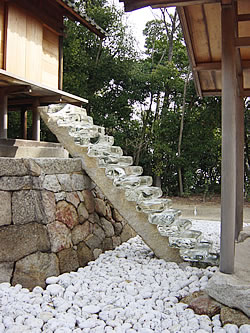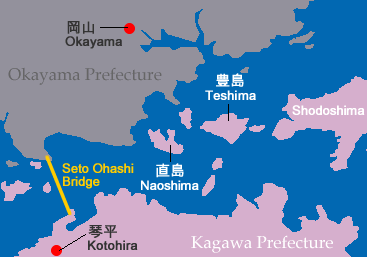 |
|
Enjoy the Inland
Sea of Japan: Setonaikai |
|




|
Okayama is not
only a major Shinkansen station, but also a gateway to Shikoku
Island, which can be reached by train crossing the Seto Inland
Sea Bridge  . .
The city itself is famous mainly for Kenrokuen, a Japanese landscape
garden.
1. Naoshima
This is an island you should not miss, a unique combination
of art resort, traditional town and industrial development.
It is home to world-class modern Japanese architecture.
2. Teshima
An island famous for a industrial waste scandal might not
be what you look for on a holiday! However, it tells an important
story about environmental issues in the Seto Inland Sea and
how residents address them, and it is still a beautiful island.
3. Kotohira Shrine (Shikoku Island)
Dedicated to the deity of the sea, this famous shrine in a
serene forest at the top of 785 stairs is a must for anybody
who loves the sea - and the mountains. Continue to: Matsuyama (Shikoku) |

|
|
Access:
From Okayama station,
take the JR Uno-line to Uno  (1
hour). Some trains are direct, otherwise you have to take the
Marine Liner train in direction of Shikoku and change at Chayamachi (1
hour). Some trains are direct, otherwise you have to take the
Marine Liner train in direction of Shikoku and change at Chayamachi
 .
Direct buses are more frequent: twice per hour from platform
8 at Okayama Station Bus Terminal. Take an express bus in direction
of Tamano .
Direct buses are more frequent: twice per hour from platform
8 at Okayama Station Bus Terminal. Take an express bus in direction
of Tamano  and get off at Uno Station (about 1 hour).
and get off at Uno Station (about 1 hour).
Uno Port is right in front of the station. Take the ferry to
Naoshima Miyaura Port (20 min., 13 boats per day) or Naoshima
Honmura Port (5 boats per day).
Naoshima can also be reached by ferry from Takamatsu (6 boats
per day)
On the island: loop bus for 100 Yen about once per hour. Rental
cycles available at the Benesse Resort and at the harbour.
Naoshima is probably one of the most curious islands in the
Seto Inland Sea. Its Northern half houses a huge industrial
complex, whereas the Southern half forms an art resort with
museums, art projects, resort hotels and beaches. The industrial
heritage began with a copper refinery, which has left the surrounding
slopes without much vegetation cover as the soils were heavily
polluted. Nowadays, the company includes a modern facility to
process industrial waste. In the Southern part, which is partly
designated as National Park, you can discover masterworks of
modern Japanese architecture, but also art blending with traditional
houses and with nature.
Activities:
 Art
and Architecture: Benesse House forms the core of the resort
area, a blend of modern art museum and hotel designed by the
famous architect Tadao Ando. Ie (=house) Project consists of
four art projects situated in the traditional center of Naoshima,
the Honmura district. Chichu Art Museum is the newest addition,
a museum build into the hillside to not disturb the landscape.
See Benesse HP for details. Art
and Architecture: Benesse House forms the core of the resort
area, a blend of modern art museum and hotel designed by the
famous architect Tadao Ando. Ie (=house) Project consists of
four art projects situated in the traditional center of Naoshima,
the Honmura district. Chichu Art Museum is the newest addition,
a museum build into the hillside to not disturb the landscape.
See Benesse HP for details.
Many public buildings like the town hall were designed by another
famous architect, Kazuhiro Ishii, giving proof of the wealth
the town accumulated due to the industrial complex it houses.
Cycling: riding around the island by bicycle is the best way
to discover all its attractions. It is possible to rent cycles
at the port or at the Benesse Resort.
Marine leisure: there are many beaches with clear water inside
the resort area. The area is also ideal for kayaking.
Accommodation:
Benesse House is a high class resort hotel complex designed by the famous architect Tadao Ando. It is one of these places were you dream of staying once in a lifetime. Accommodation is available in different buildings, called the Museum, Oval, Park and Beach, with varying prices and facilities.
HP: http://www.naoshima-is.co.jp/english/first.html
Oyaji no umi  is a small, cheap, cosy minshuku in the middle of the traditional
district of Honmura. Rooms are separated by sliding doors,
so donft expect much privacy, but friendliness makes up for
it!
is a small, cheap, cosy minshuku in the middle of the traditional
district of Honmura. Rooms are separated by sliding doors,
so donft expect much privacy, but friendliness makes up for
it!
HP: http://mypage.odn.ne.jp/home/stone_ocean
(Jap.)
Mail: pink-bunnys@mx8.tiki.ne.jp,
Tel. 087-892-2269 (Jap.)
Links:
Kayak: HORIZON (Contact: Mr. Ozaki)
Tel/Fax: 088-686-6525
Mail:kayak110@nifty.com
(Engl. mail ok)
http://www.e-horizon.jp
(Jap.) |

|
Access:
By ferry from Uno Port (see above) (40 min, 8 boats per day).
Take the boat for Shodoshima
 .
Make sure not to take the boat to Naoshima. .
Make sure not to take the boat to Naoshima.
Teshima is an island for those who are interested in environmental
issues. It was the stage of one of the biggest industrial
waste scandals, where almost 600.000 tons of waste were accumulated
illegally until the early 1990s. Teshima Residents took Kagawa
Prefecture to court over the waste scandal and made the prefecture
take responsibility for correctly processing and clearing
the waste from the island. Since 2003, the waste has been
transported to nearby Naoshima and processed in one of the
most modern facilities in the country. The residents group
offers guided tours of the site and of the island in Japanese.
Accommodation:
there is a small resort facility, Amare Teshima
Resort, with cottage-style rooms facing the beach:
http://www.newosakahotel.com/html/jap/teshima/
(Jap.) Links:
Teshima Residents Association  is the residents group that has been actively working for
a solution to the waste problem:
is the residents group that has been actively working for
a solution to the waste problem:
http://www.teshima.ne.jp/
(Jap.) |

|
|
Access:
Take the Marine Liner train on the JR Seto Ohashi line (1
hour). From Kotohira station, it is about 15 min. walk to
the beginning of the long stairway that leads up to the main
hall.
Traveling by train over the Seto Ohashi Bridge, the first
bridge to link Honshu and Shikoku in 1988, offers you good
views of the sea beyond.
In Kotohira, the town's homepage gives you all the necessary
information to walk around town. Don't give up on the stairs
to the main hall - there is plenty to see on the way, and
the view from the top is impressive! Also try to get a glimpse
of the new shrine office to the left if you are facing the
main hall - it was built partly underground to keep the impact
on the landscape as small as possible. Large iron plates were
used to symbolize a ship. If you have time for a longer stroll,
keep on going to Okuno-in  ,
the inner sanctuary. ,
the inner sanctuary.
Kotohira is an ideal base to start exploring Shikoku, e.g.
continue to Matsuyama.
Accommodation:
there are about 20 ryokan in town, many of them with onsen
facilities.
http://www.town.kotohira.kagawa.jp/onsen/
(Jap.)
Links:
Kotohira town Homepage:
http://www.town.kotohira.kagawa.jp/english/index.html |
|
|


